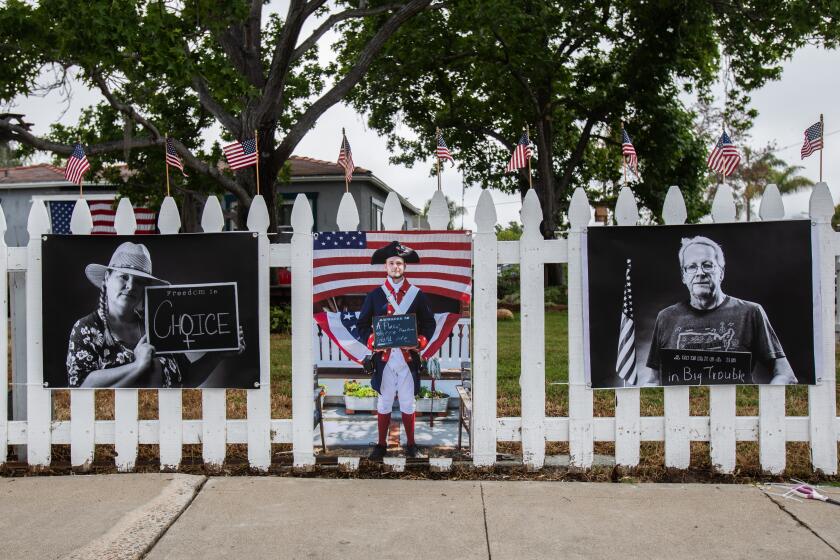The ‘haunting’ side of Coronado bridge
In “The Incident on the Bridge,” her new young-adult novel, Laura McNeal writes about a teenage girl who disappears after parking the car she’s driving on the San Diego-Coronado Bridge. Did she jump? Assumptions get made.
McNeal was a National Book Award finalist for an earlier YA novel, “Dark Water.” The Coronado resident will be at Bay Books in Coronado at 4:30 p.m. next Sunday and at the Mission Valley Barnes & Noble at 2 p.m. on June 11.
Q: What drew you to this story?
A: I spend a lot of time looking at that bridge. I can see it from my house, and I go running and ride my bike under it a lot. So there was that proximity. During the five years I was writing it, I was learning more and more about the frequency with which people go up there and either threaten to jump or do jump.
I’ve always loved the bridge, as I think so many people do. It’s so beautiful. The view is so beautiful from the top, and I think it’s beautiful when you are looking at it from below. It always made me feel really happy, and it started to have this haunting side to it once I imagined it from the point of view of a person who was going up there in order to disappear, essentially.
Q: What impact do bridge suicides have on the daily life of the people who live there?
A: It affects many people I know emotionally to a surprising degree. I know many people who either witnessed someone jumping or who have seen someone about to jump. We all have this sense as we are driving over it, “Oh, please don’t let anyone stop.”
I also impacts traffic a lot, keeps people for hours from getting places. There are people who are sympathetic to the depressed individual and then there are people who are just really angry and impatient and very tired of the delays.
Q: You tell this story in alternating chapters from the viewpoints of various characters. Tell me about the decision to do it that way instead of through one main narrator.
A: I did write the book two other times. The first time I told it all from Fen’s point of view in first person. (He’s the nephew of a Coronado police officer.) But it was very hard from Fen’s point of view to ever imagine what Thisbe (the missing teen) was thinking, and it was very much about him trying to help Ted (Thisbe’s sister) cope with the disappearance.
The second time I told the story it was Fen and Ted writing it together and sort of competing to tell the story in a different way. But I still really felt that what I was leaving out of it was Thisbe’s state of mind and also all of that context you get from being in the point of view of the uncle who is the police officer and the adults who are faced with the search and the job of taking care of everything afterward.
I really do feel that even though young-adult fiction very often focuses on a teenager’s point of view, one of the great things about literature when you’re that age is learning to see the world through an adult’s point of view, to sort of get out of your own tiny, frightening little peer-locked world and to see the larger context. That was what I was trying to do.
Q: Did you have any themes in mind as you started this story?
A: One of my preoccupations is the question of whether things are fixed or whether they can be changed, whether we can change them for ourselves or for someone else. It always strikes me when someone does stop, as someone did a few years ago on the bridge to talk someone out of jumping. That’s a person who believes, “I can change this situation. I can convince this person to live a little longer, to hope a little longer.”
That kind of hope and trust in your own ability to save someone, rather than just sort of letting things happen, interests me. The pessimism and the optimism. In the book, Fen keeps throwing dice, wondering if he can get a sign from somewhere about what he should do.
One of the things I thought about the whole time I was working on it, very early on before I had much of a plot, was realizing that when I go running on the beach I can’t not stop to pick up a sand dollar because I think they’re good luck. Sometimes I’m running home and I have 10 sand dollars, five in each hand, and I’m looking at them and thinking, “This is a skeleton of a sea creature. Why is that lucky? Why is this a sign of anything?” But ultimately it’s this fragile thing that’s been pounded and beaten and yet it’s still full and still somehow beautiful. To me, that contrast, that paradox, was at the center of the book.
Q: Another thing you’re writing about is the assumptions that are made about Thisbe and what happened to her. What do you find interesting about that?
A: I think we often believe, especially when we’re teenagers, that we know what people think about us and we’re often quick to make judgments about what someone has done or why they did it. Most of the characters are mistaken. Often people are not thinking what you think they are, and you may be wrong in the way you are interpreting events, too, and it’s important to suspend judgment and not make impulsive decisions based on those interpretations.
Q: This book is aimed at readers ages 12 and up. What do you like about writing for the young-adult readers?
A: I feel like a young reader is really potentially more vulnerable and more impressionable, and books really saved my life when I was that age. Books still matter a great deal to me, but at that time, they were this way for me to figure out the way the world worked and the way other people were thinking. If I hadn’t had that, I think I just would have been lost.
I mean this in the humblest possible way: I would like to be able some day to do that for a young reader, to be that world they can go into and sort of figure things out, and that I could be sort of a trusted guide to a hopeful view of things. I like it to be true but also hopeful.






